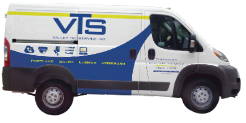When it comes to security camera installation for your business, there are many options to consider. To make the most of your security system, take the time to determine what your needs and goals are. Do you need indoor cameras, outdoor cameras, or both? Do you need to view footage remotely? How long do you need to store footage? By understanding what your key needs are, we can help you select the best system for your business.
What Makes Up a Security Camera System?
The basics of a security camera system include one or multiple security cameras, a network video recorder (NVR) or DVR, storage (such as hard drives), and cabling/wiring. There are countless ways to configure these pieces that will affect your security system’s quality, effectiveness, and capabilities.
What Should You Consider?
Before your security system is up and running, determine what you will need from the system. Some elements to consider are whether you want to remotely view footage, how much storage you will need, and what types of areas you want to monitor.
IP Camera Installation
These days, IP camera systems are increasingly common. With these systems, you can stream camera footage from mobile devices or in your web browser. Installing these systems requires Cat5e and Cat6 cables, which can quickly transfer digital video at high resolutions over long distances. You will also need to connect your network video recorder (NVR) to the same IP network as your camera.
How Much Storage Do You Need?
Cameras that record high-resolution video can quickly take up substantial amounts of storage. You will want to figure out how much storage you will need by combining the bitrate, resolution, and length of footage you wish to keep. Many businesses keep footage for at least 30 days and others keep footage for at least 90 days. To avoid stacking up hard drives, you can opt for cloud storage. With cloud storage, you can access live and recorded footage from a mobile device or web browser.
What Is Your Purpose for Recording?
Security cameras can have many uses for business establishments. Some common uses are deterring theft, ensuring safety, and improving efficiency. Knowing your intent and the specific locations you need to monitor will help you select the optimal cameras for your business.
Outdoor Cameras
For many businesses, it is critical to monitor the perimeter of their facility. Whenever a camera is placed outdoors, it’s especially important that the camera is weatherproof. Bullet cameras are a great option as they often come with a weatherproof hood. If you need a wide-angle view of a parking lot or entrance, a fisheye camera is a good option.
Indoor Cameras
With indoor cameras, you can trade some durability for more versatility. Dome cameras are often mounted indoors and cover wide areas while staying hidden from sight. Turret and point-tilt-zoom (PTZ) cameras are good options if you want to redirect your field of view without remounting the camera.
More Security Camera Installation Tips
Wherever you decide to install security cameras, it’s important to cover the front door, back door, and first-floor windows. You should always try to avoid blind spots and ensure the cameras have enough lighting. Additionally, place cameras high enough to prevent tampering and make sure to position them so they aren’t facing direct sunlight.
An often overlooked part of the security camera installation process is wiring. Sometimes wires can easily be dropped through a ceiling tile into the wall, but other times you will need to feed them through with a conduit or even tear out part of a wall. To protect the wires, you can cover them in EMT conduit, and if you want them to stay discrete, you can paint them.
Security Camera Installation with Valley Tel Service
VTS provides security camera installation for all types of businesses in the Pacific Northwest. We help you determine what system is best for your business and then install it to meet your specific requirements. To get started, give us a call or send us a message.







